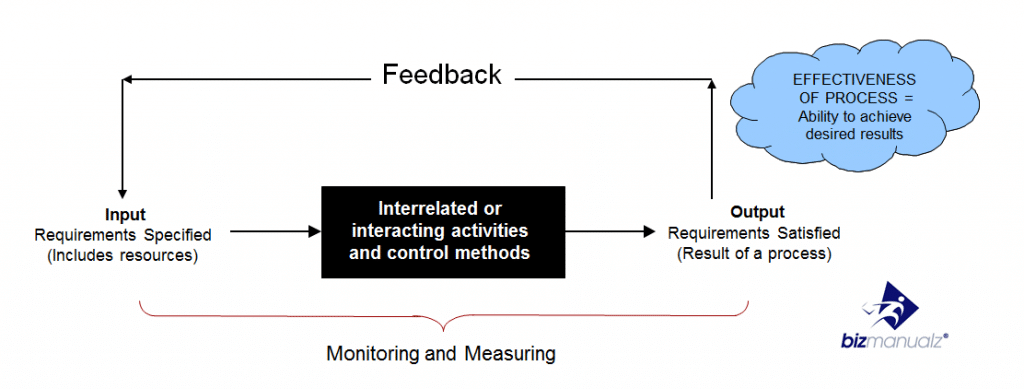What Are The Essential Elements of a Process?

Grasping the core parts of a process is vital. These basics form an effective and efficient workflow, ensuring success. What are the essential elements of a process?
Building Blocks of a Process
Process efficiency and flexibility are synergistic. When brought together, they create a potent dynamic that optimizes output while keeping the ability to take on unforeseen variables.
Process Efficiency
Efficiency is fundamental for a successful process. Streamlining tasks and reducing wastage boosts productivity. This requires procedures to get rid of unneeded steps and promote a seamless transition between various stages of the process.
Process Flexibility
Flexibility is a major factor that allows a process to alter and grow as circumstances change. This permits people or organizations to adjust their strategies when encountered with unanticipated issues or new chances.
Suggested Actions
To enhance efficiency of a process, one can start by assessing regularly to find weak spots or areas for improvement. By spotting inefficiencies early, one can take proactive steps like automation or rearranging tasks to make sure optimal flow.
Moreover, promoting open communication and feedback channels within the team helps advance flexibility. Inviting team members to share their ideas and worries builds an atmosphere where imaginative solutions can develop amidst changing circumstances.
Definition of a process
A process is a set of steps taken to achieve a goal. It needs an organized and communicative approach to be successful. Let’s analyze the main elements:
Element 1: Organization
Organizational skills are essential for any process. A structured way of doing things reduces errors and increases productivity. Breaking down tasks into smaller ones makes it easier for individuals and teams to complete the process. Guidelines, timelines, and responsibilities help maintain accountability and work collaboration.
Element 2: Communication
Communication is necessary for any process. It ensures that information is shared between stakeholders smoothly. Expectations, feedback, and potential issues are addressed with clear, concise communication. Through proper channels, ideas, instructions, and updates are transmitted throughout the process.
Organization and communication are the foundations of a successful process. Every process is unique, with specific requirements and characteristics. These depend on industry standards, technological advancements, and individual preferences.
Processes have been part of human civilization since ancient times. Humans have always looked for ways to make their activities more efficient. The evolution of processes has been pushed by innovation and adaptation to changing circumstances.
Importance of understanding the elements of a process
A deep comprehension of process elements is vital for successful implementation. Knowing these components allows people to navigate complex processes with confidence and accuracy. Without this understanding, inefficiency and mistakes are more likely to happen. So, understanding the key elements of a process is essential.
Input and output are two important factors when exploring process elements. Input is the resources or info needed to start and continue the process. It provides a base for the following actions. Output, on the other hand, is the desired result at the end of the process. It measures success and shows if goals have been reached. Knowing both input and output helps to determine how pieces link together and progress continues.
Another part to consider is how elements link together. Every component relies on each other to work properly. If one element has a delay or doesn’t work, it can cause problems throughout the system. Being aware of how each element connects and affects other parts allows better problem-solving.
SIPOC Describes a Process
SIPOC stands for Suppliers, Inputs, Process, Outputs, and Customers. The individuals or companies that supply the process’s inputs are known as suppliers. Information, tools, and materials are examples of inputs. The actions used to create the outputs are called the Process.
It’s crucial to thoroughly review each step. The results of the operation are called outputs. Clients receive the results and gain from them. Understanding their requirements and expectations is essential for a successful conclusion.
Research by Florian Biermann et al., published in International Journal of Production Economics, supports this. It shows how a thorough understanding of process elements leads to better performance across industries.
By knowing and appreciating the elements in a process, people can navigate complexities easily and reduce potential errors or blocks. Realizing that input and output are essential for success boosts efficiency and helps with today’s fast-paced business landscape. So, having a good grasp of these elements is key to excelling!
Essential Element 3: Clear objectives
To achieve success in a process, you need clear objectives. Clear objectives in a process help guide your actions and measure your progress. In this section, we’ll explore the importance of setting clear objectives and provide examples from different industries to illustrate their significance.
Explanation of the importance of setting clear objectives in a process
Objectives must be clear for a process to succeed. They offer direction, purpose and act as a roadmap for decisions and resources. Clear objectives help teams stay focused, manage tasks and save time. Moreover, they enable communication between team members and stakeholders, driving collaboration. Ultimately, clear objectives set the stage for a successful process.
Examples of clear objectives in different industries
Clear objectives are key to success in various industries. Let’s check out some examples!
Industry: Objective
- Healthcare: Reduce patient wait times with efficient appointment systems.
- Transport: Increase customer satisfaction by cutting travel time and boosting on-time performance.
- Retail: Grow online sales with a user-friendly website featuring personalized recommendations.
- Manufacturing: Enhance productivity through lean manufacturing and reducing waste.
- Tech: Increase market share by reaching new demographics and offering fresh solutions.
These examples show the significance of clear objectives in different industries. Each one is tailored to address particular issues and reach desired outcomes. By defining what needs to be done, organizations can guide their efforts towards success.
To make sure objectives are effective, it’s essential to:
- Create SMART goals: Specific, Measurable, Attainable, Relevant, and Time-bound goals bring clarity and focus.
- Communicate objectives clearly: Clear communication makes sure everyone knows their roles in achieving the objective.
- Track progress regularly: Monitoring progress helps detect any deviations from the desired outcome and allows for quick adjustments.
- Provide necessary resources: Adequate resources let employees work efficiently towards achieving the set objectives.
Using these tips, organizations can effectively implement clear objectives that drive growth and success in their industries.

A process is a series of steps taken to transform an input into an output.
Essential Element 4: Well-defined steps
To ensure a seamless and efficient process, it is crucial to have well-defined steps in place. In this section, we will dive into the significance of this essential element, along with providing a detailed description of the typical steps found within a process. Understanding these components will enable you to navigate through any process with clarity and effectiveness.
Explanation of the significance of having well-defined steps in a process
Having a clear set of steps in a process is key for efficiency and effectiveness. Easy to understand and follow instructions make it simpler to avoid confusion and mistakes. Defined steps also provide a structure to monitor progress and recognize areas of improvement. Following a systematic method, businesses can get the same results and optimize their workflows.
Furthermore, well-defined process steps improve communication within a team. Everyone involved in the process knows what to do, making it simpler to assign tasks and work together. This leads to better coordination and productivity.
Moreover, having a documented procedure helps with training and onboarding new staff. An organized procedure helps transfer knowledge quickly, so new hires can get up to speed quickly. This saves resources that would otherwise be used for extended training sessions.
By using well-defined steps, organizations can also make sure they meet regulations and standards. Clear procedures demonstrate that they follow specific rules and guidelines. This lessens the risk of legal issues and keeps customers satisfied by making sure the product quality or service stays consistent.
Detailed description of typical steps in a process
Having a detailed description of the typical steps in a process is essential for running smoothly and achieving success. Breaking it into clear steps makes it easier for people to understand and do what’s needed to reach their goals. Here’s a four-step guide to show the importance of a detailed description of typical steps in a process.
- Identify objectives: First, it’s important to define the objectives or goals that need fulfilling. This means understanding the purpose of the process and what needs to be done at each stage. Defining objectives helps everyone stay focused and on track.
- Break it down: After objectives are set, break the process into smaller, manageable tasks or sub-steps. This makes it more understandable and easier to execute each action. Breaking complex processes into simpler steps also organizes and manages time better.
- Provide instructions: For every step, include detailed instructions on how to do it. These instructions should be clear and leave no room for misunderstanding. Graphics, flowcharts, or examples can also help explain better.
- Review & improve: After completing each step, review and evaluate its effectiveness. Check if all actions were done correctly and look for ways to improve the process. Feedback from those involved can help refine the process and make it more efficient.
Good communication between those involved is also important. Set checkpoints or milestones to monitor progress and stick to deadlines. Following these suggestions helps create an effective process and increases productivity. A detailed description of steps in a process is key for successful outcomes and improved workflow.
Benefits of having clear objectives and well-defined steps in a process
Having clear objectives and well-defined steps in a process brings huge advantages. It gives a roadmap for understanding goals and expectations. It helps to distribute resources and manage time. It boosts communication, letting everyone know their roles. It also simplifies the evaluation of progress and recognition of improvement areas.
Plus, this approach generates a sense of focus and direction. It eliminates doubts and perplexity by giving a structured plan. By splitting complex tasks into simpler, doable steps, individuals can advance to the bigger aim effectively.
A unique feature is that it encourages responsibility among team members. With transparent steps, people recognize what must be done and when. This encourages ownership of tasks, leading to higher productivity and timely completion of deliverables.
Pro Tip: When setting goals and steps in a process, involve all related stakeholders to make sure a full approach that considers different views and experience. This will lead to stronger outcomes.
Essential Elements of a Process
Two elements form the basis of any process: essential for successful outcomes and efficiency. But, these elements alone may not guarantee desired results. Therefore, additional factors must be considered.
Effective communication is an important factor. Clear and concise communication enables stakeholders to understand their roles and responsibilities, align objectives and exchange info needed for decision-making. Open lines of communication minimize misunderstandings, optimize resource allocation, and encourage collaboration.
Continuous improvement is key. Processes should not be seen as static, but rather as adaptive systems that can be refined and continuously improved. Evaluating processes and seeking feedback drives innovation, enhances productivity and keeps companies competitive.
Organizations can adopt strategies to enhance process effectiveness. Provide training and resources so employees have the knowledge and tools to deliver high-quality work consistently. Incorporate automation to streamline tasks, reduce errors and increase productivity. Establish accountability measures to hold individuals responsible for their actions and motivate employees.
Frequently Asked Questions
1. What are the two essential elements of a process?
Answer: The two essential elements of a process are inputs and outputs. Inputs refer to the resources or materials that are required to initiate and carry out the process. Outputs, on the other hand, are the desired results or outcomes produced as a result of the process.
2. Why are inputs important in a process?
Answer: Inputs play a crucial role in a process as they provide the necessary resources or materials needed to perform the desired tasks. Without proper inputs, a process cannot function effectively or efficiently, leading to subpar outcomes.
3. What are some examples of inputs in a process?
Answer: Examples of inputs in a process can vary depending on the context. They can include raw materials, information, energy, human resources, equipment, technology, and any other necessary components or elements required for the process to occur.
4. What is the significance of outputs in a process?
Answer: Outputs are essential in a process as they represent the desired outcomes or results that the process aims to achieve. They indicate the effectiveness and efficiency of the process, and their quality and value determine the overall success of the process.
5. Can an output become an input in a subsequent process?
Answer: Yes, an output from one process can often become an input for another process. This is known as the input-output relationship, where the output of a particular process serves as the input for a subsequent process, forming a continuous chain of interconnected processes.
6. How can the relationship between inputs and outputs be optimized in a process?
Answer: The relationship between inputs and outputs in a process can be optimized through various methods such as refining the process design, improving resource allocation, enhancing technological capabilities, eliminating bottlenecks, and continuously monitoring and evaluating the process to identify areas of improvement.


















Leave a Reply